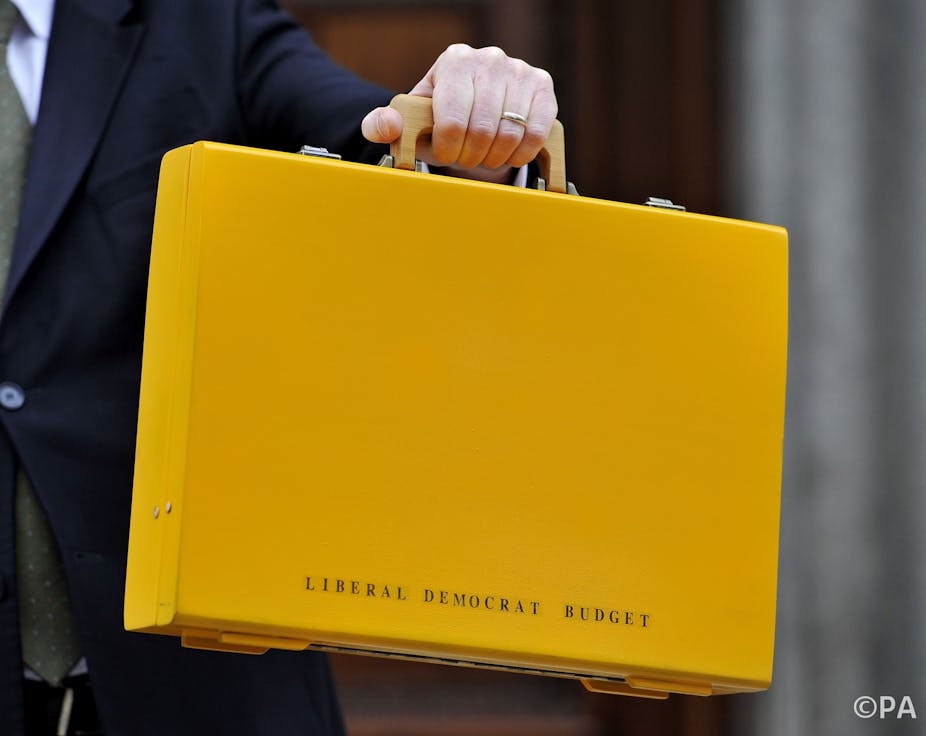Danny Alexander’s “Lib Dem Budget” and his lurid yellow box have provoked predictable ridicule from a hostile press. But while the constitutional novelty of the chief secretary to the treasury’s “alternative budget” might look like a flop today, it may not matter come May.
In a deserted House of Commons, Labour’s Chris Leslie dismissed the Lib Dems’ statement from the dispatch box as a “farce”. The Huffington Post described Alexander as a “laughing stock”.
Yet events at Westminster may not matter so much for the Liberal Democrat election strategy. After all, their target in May is realistically not to gain, but to keep, as many votes and seats as possible. This will not be done on national television or the benches of the Commons, but in the 57 constituencies the party holds (or rather, a proportion of them).
Tailor-made campaigns
Each of those constituency campaigns is crafting its own designer version of the party message, tailoring the Lib Dems’ participation in government to local circumstances. In some seats the emphasis is on deficit reduction; in others, equal marriage; in some free schools, and in others free school meals. In most constituencies, apprenticeships and the raising of the tax threshold will attract votes and be recognised as distinctive Liberal Democrat contributions to a coalition government.

The proposals in Alexander’s yellow budget – notably those concerning higher public spending than is planned by George Osborne – will doubtless find their way into this mix. The traditional liberal tactic of tailoring campaigns to seats and issues involves linking Lib Dem achievements with brutal clarity to practical changes in the constituency. For example, how many teaching assistants the Pupil Premium has brought to the local school.
The perks of being a wallflower
There is also evidence of a reversion to the appeal of the Liberal Democrat MP as the independent-minded local representative. Many seek to attract support through their roles in cross-party campaigns against everything from female genital mutilation, to forced adoption, to the abandonment of cheques by clearing banks. Some are even using predominantly “unbadged” election material to promote their campaigns.
Liberal Democrat candidates are relying on constituency networks – including local government representation – to consolidate their vote, in the style of Liberal MPs of the 1970s. This is reflected in Tim Farron’s Liberal Democrats in Westmorland and Lonsdale outpolling all other parties, even at the dismal 2014 European elections. It is also evident in Birmingham Yardley, where John Hemming is the Lib Dem MP, and all local council seats have been held by the party despite disastrous losses across the city.
There’s evidence that this approach works. Tim Smith’s study of the 2010 election showed that the Liberal Democrats enjoy an advantage worth between five and 15 percentage points over their rivals when their candidate is the sitting MP. “Where a Liberal Democrat MP gets in,” said Smith, “they are often able to entrench themselves, making it extremely difficult for Labour or more often the Conservatives to regain the seat.”
The tactical scenario between the Lib Dem MPs’ challengers of each winnable constituency is exploited to harvest the maximum vote by reminding the third party’s supporters that the Lib Dems are best placed to beat the second-placed.
This week’s events in the Commons may they tempt the main parties to forget about the Lib Dems. They do so at their own peril. The Labour and Conservative campaigns which overlook this parliamentary wallflower will find it hard to uproot on the ground.

